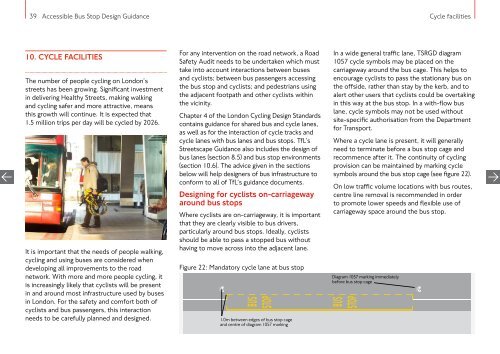ACCESSIBLE BUS STOP DESIGN GUIDANCE
bus-stop-design-guidance
bus-stop-design-guidance
You also want an ePaper? Increase the reach of your titles
YUMPU automatically turns print PDFs into web optimized ePapers that Google loves.
39 Accessible Bus Stop Design Guidance<br />
Cycle facilities<br />
10. CYCLE FACILITIES<br />
The number of people cycling on London’s<br />
streets has been growing. Significant investment<br />
in delivering Healthy Streets, making walking<br />
and cycling safer and more attractive, means<br />
this growth will continue. It is expected that<br />
1.5 million trips per day will be cycled by 2026.<br />
It is important that the needs of people walking,<br />
cycling and using buses are considered when<br />
developing all improvements to the road<br />
network. With more and more people cycling, it<br />
is increasingly likely that cyclists will be present<br />
in and around most infrastructure used by buses<br />
in London. For the safety and comfort both of<br />
cyclists and bus passengers, this interaction<br />
needs to be carefully planned and designed.<br />
For any intervention on the road network, a Road<br />
Safety Audit needs to be undertaken which must<br />
take into account interactions between buses<br />
and cyclists; between bus passengers accessing<br />
the bus stop and cyclists; and pedestrians using<br />
the adjacent footpath and other cyclists within<br />
the vicinity.<br />
Chapter 4 of the London Cycling Design Standards<br />
contains guidance for shared bus and cycle lanes,<br />
as well as for the interaction of cycle tracks and<br />
cycle lanes with bus lanes and bus stops. TfL’s<br />
Streetscape Guidance also includes the design of<br />
bus lanes (section 8.5) and bus stop environments<br />
(section 10.6). The advice given in the sections<br />
below will help designers of bus infrastructure to<br />
conform to all of TfL’s guidance documents.<br />
Designing for cyclists on-carriageway<br />
around bus stops<br />
Where cyclists are on-carriageway, it is important<br />
that they are clearly visible to bus drivers,<br />
particularly around bus stops. Ideally, cyclists<br />
should be able to pass a stopped bus without<br />
having to move across into the adjacent lane.<br />
Diagram 1049 marking<br />
Figure 22: Mandatory cycle lane at bus stop<br />
1.0m between edges of bus stop cage<br />
and centre of diagram 1057 marking<br />
In a wide general traffic lane, TSRGD diagram<br />
1057 cycle symbols may be placed on the<br />
carriageway around the bus cage. This helps to<br />
encourage cyclists to pass the stationary bus on<br />
the offside, rather than stay by the kerb, and to<br />
alert other users that cyclists could be overtaking<br />
in this way at the bus stop. In a with-flow bus<br />
lane, cycle symbols may not be used without<br />
site-specific authorisation from the Department<br />
for Transport.<br />
Where a cycle lane is present, it will generally<br />
need to terminate before a bus stop cage and<br />
recommence after it. The continuity of cycling<br />
provision can be maintained by marking cycle<br />
symbols around the bus stop cage (see figure 22).<br />
On low traffic volume locations with bus routes,<br />
centre line removal is recommended in order<br />
to promote lower speeds and flexible use of<br />
carriageway space around the bus stop.<br />
Diagram 1057 marking immediately<br />
before bus stop cage



